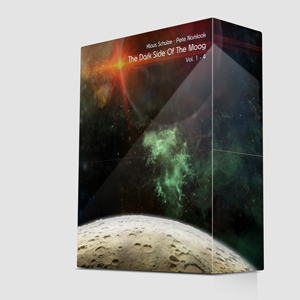
- 5CD Boxset // 5CD Jewel Case Box
- Date : 29.01.2016 // 13.05.2022
- Package : 5CD Boxset Sliplid // 5CD Jewel Case Box
- Running Time CD 1 : 51:19 Min
- Running Time CD 2 : 61:01 Min
- Running Time CD 3 : 59:00 Min
- Running Time CD 4 : 58:17 Min
- Running Time CD 5 : 67:42 Min
- Details : Limited Edition Boxset Sliplid (2016)
Klaus Schulze & Pete Namlook – The Dark Side Of The Moog
The Dark Side Of The Moog
In 1994, Klaus Schulze was able to look back on a long, successful and highly influential career, but he was also able to embrace the new. He was in the midst of his ‘digital phase’, fascinated by sampling technology, and had a clear idea of where he could go with the technology, which resulted in albums like ‘Beyond Recall’; the Royal Festival Hall recordings; ‘The Dome Event’ and even to an extent his opera ‘Totentag’.
By contrast Peter Kuhlman a.k.a Pete Namlook had just started. In 1992 he had founded the seminal Fax label, which was both a vehicle for his own recordings and a chance to collaborate and release recordings from like-minded musicians from around the world: Robert Görl of DAF; Geir Jenssen of Biosphere fame; the ever-eclectic Bill Laswell; Lorenzo Montanà; Gabriel Le Mar; Dr. Atmo and David Moufang to name just a few. The label made a huge name for itself in a very short time, crossing borders and garnering praise from the chill-out rooms of the club scene to the hearts of fans of serious electronica who knew authenticity when they heard it. But that wasn’t just a different world away, it was almost a different generation too.
Meanwhile, as always in the musical life of Klaus Schulze, things moved in curious cycles and seasons, and chance was to play a big part in his next project.
In preparation for an interview with Klaus, writer Rüdiger Frankenbach asked Klaus if he could bring a musician friend along to meet him – it was Pete Namlook, and although there was a spark between them nothing more came of it.
Things however were to change when Klaus heard Namlook’s 1994 album ‘Air II’.
In an interview from 2002, Pete remembered:
“In fact, the detonation was ‘Air II’ – the spacey part of the track ‘Travelling Without Moving’ enthused Klaus. He wanted us to start to work together at once. It was the music that was of importance to him.
Although Klaus had had no interest in working together before on principle, I knew I could convince him with my music. That was the key of our co-operation. The track was in a sort of Schulze/Tangerine Dream style with it’s analogue synthi-bass sequences; it became apparent to both of us that we should approach things with analogue tools first of all. Although it wasn’t so easy initially, the musical result finally convinced him. I didn’t want to do just a remake of seventies space-music – I intended to meld it with the beats and sounds of today’s electronic music, and I think we succeeded.”
Their relationship and the exchange of ideas was unorthodox from the beginning, in that they rarely met personally. The most remarkable contacts they had were outside of their studios, for instance their concert of April 1999 at the Jazz Festival in Hamburg , which was released as an edited version on ‘Dark Side Of The Moog, Vol.8’ – the interplay and chemistry between them is clearly evident, and it becomes even clearer on the un-edited version of the concert.
In the years that followed they exchanged ideas, sketches and recordings via post and the internet see-sawing the music until the tracks developed, but always with the final mix left to Pete.
Klaus Schulze: “The whole series was a very unpretentious project. Because I had always kept total control with my own albums, I let Pete take it off my hands and could make compromises. That was juicy for me, ‘cause I don’t work with other electronic musicians usually. It was a total different chemistry compared to say Manuel Goettsching, who I understand completely. From that point of view it was a real challenge. I never could work with somebody like me, I’d rather do it on my own. The few people I have worked with, like Rainer Bloss, had to have strong egos to prevent themselves being dominated by me. Namlook once said, my music was often too emotional from his point of view. Namlook is much more rational than me, that’s why I always kidded him with the nickname ‘the banker’ – but this oppositional aspect made it exciting for me. I need people who work contrari-wise.
Work on ‘Dark Side Of The Moog’ started without any solid intention and wasn’t planned as a series at all. There was only the aim that it didn’t sound like ‘Schulze’ only, so I decided that Namlook had to make the final mix.”
The influence Namlook had on Klaus’s music in the middle of the nineties should not be taken lightly, because although Klaus dearly loved those early-analogue elements from his own music, they had become, to an extent, lost. It was Pete who fortified him to go back to the analogue charm of his early albums and it was Pete who supported him in the modification of his analogue instruments, leading finally to the epoch-making Schulze album from 1996 – “Are You Sequenced?”
Klaus Schulze: “Namlook recognized my strength in analogue working. He argued that too many people are working with pre-sets nowadays and my style was still unique. At first I bristled, ‘cause it looked like a step back in my eyes, but in the end creativity is essential. On the other hand for the (at that time) younger generation of working digital musicians my style was very new, ‘cause they were already caught up in their own work with pre-sets.
I make music very emotionally, Namlook was more a planner. That became clear in concert. Pete intended to prepare the whole performance, while my intention was just to play what came to my mind. Regardless of this big difference it was a very beautiful; an inspirational gig and it shows how great our co-operation worked. I think, this feeling of freedom was quite good for Pete, too.
I learned from him that not only repetition, but also conciseness, is delightful. Although his melodies often were too close to mainstream in my opinion, together with my basics it worked fine.”
For Namlook, the curiosity of Klaus Schulze and their collaboration on a level playing field of mutual respect was inspiring:
“Klaus is open to new sounds, although he has his own personal style. I appreciate Klaus, because music is the most important thing for him instead of any neuroses or egomaniac behaviour. It’s the result that counts and from the first moment he listened to me he gave kudos to my musical opinions; likewise I demonstrated my respect for his opinions too. The co-operation always was at eye-level. Although Klaus of course did a lot more for electronic music, being one of the true, original pioneers, who could (if he wanted) think a great deal of himself, he never let me feel this.”
And so a legendary series of recordings was born. ‘Dark Side Of The Moog’ grew more or less unplanned to a sprawling, stately-sized series of eleven volumes recorded between 1994 and 2008, only ending with the early, tragic death of Pete on November 8th 2012.
The name of the project and the title were a gag from the beginning.
Klaus Schulze: “I always had a problem with titles. So we had the idea, to take changed Pink Floyd titles. But it’s no homage to Pink Floyd and direct references don’t exist. And it wasn’t planned. The name of the project came to my mind, because the Moog synthesizer was the connecting instrument of our work. Robert Moog himself took the series as a great compliment. Namlook and I met him at the Frankfurt Music Fair, where the only existing photograph of us all together was made.”
Retrospectively, the approach to and exchange of music and ideas, the growing together and cross-pollination of emotion and logic, makes for a rewarding and fascinating listening experience that still holds its own today.
We’ll leave the final words to the two creators.
Pete Namlook:
“It’s not possible to highlight one individual album without downgrading the other ones. The entity of the releases is simply unthinkable without each individual collaboration.”
Klaus Schulze:
“It’s an important document, because it shows, how technology has changed in time. In 1975 for example you had visions that you just couldn’t realise with the tools of that time. Yet technology advanced so much that it became possible to realise almost everything. You got more input through technology, but at the same time it was a challenge to pare it all back down, to select and make choices. ‘Dark Side Of The Moon’ was a valuable experiment from this point of view, too.”
Ecki Stieg, 2015
Your can reach Ecki Stieg’s “Grenzwellen” radio-special about “The Dark Side Of The Moog” including a detailed interview with Klaus Schulze via this link to the soundcloud stream!
Tracklists
CD 1
Wish You Were There
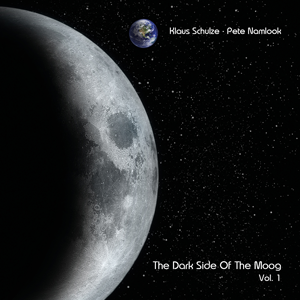
- 1. Part I – 05:02
2. Part II – 05:00
3. Part III – 05:01
4. Part IV – 04:59
5. Part V – 05:00
6. Part VI – 05:00
7. Part VII – 05:00
8. Part VIII – 05:00
9. Part IX – 05:00
10. Part X – 06:17
Total: approx. 51:19
CD 2
A Saucerful Of Ambience
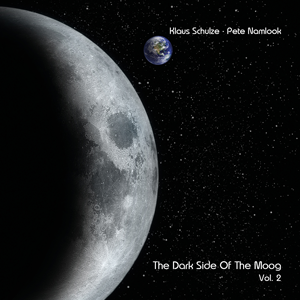
- 1. Part I – 05:00
- 2. Part II – 05:00
- 3. Part III – 05:00
- 4. Part IV – 05:00
- 5. Part V – 05:00
- 6. Part VI – 05:00
- 7. Part VII – 05:00
- 8. Part VIII – 05:00
- 9. Part IX – 05:00
- 10. Part X – 05:00
- 11. Part XI – 05:00
- 12. Part XII – 06:01
Total: approx. 61:01
CD 3
Phantom Heart Brother
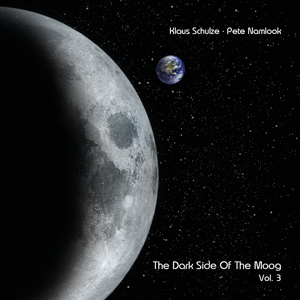
- 1. Part I – 18:26
- 2. Part II – 12:16
- 3. Part III – 10:06
- 4. Part IV – 06:12
- 5. Part V – 09:12
- 6. Part VI – 02:48
Total: approx. 59:00
CD 4
Three Pipers At The Gates Of Dawn
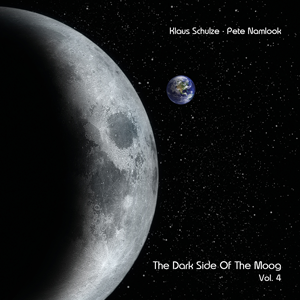
- 1. Part I – 06:56
- 2. Part II – 21:48
- 3. Part III – 04:57
- 4. Part IV – 02:21
- 5. Part V – 02:28
- 6. Part VI – 07:57
- 7. Part VII – 02:53
- 8. Part VIII – 08:52
- 9. Part IX – 01:51
Total: approx. 58:17
CD 5 (Bonus)
The Evolution Of The Dark Side Of The Moog
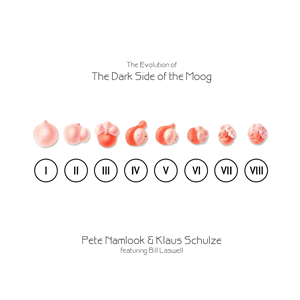
- 1. Intro (feat. Robert A. Moog) – 00:12
- 2. Wish You Were There (Excerpt) – 03:32
- 3. A Saucerful Of Ambience (Excerpt) – 15:01
- 4. Phantom Heart Brother Part III – 05:25
- 5. Phantom Heart Brother Part IV – 06:17
- 6. Three Pipers At The Gates Of D. Part VII – 02:39
- 7. Three Pipers At The Gates Of D. Part VIII – 08:45
- 8. Psychedelic Brunch – 08:03
- 9. Obscured By Klaus – 07:57
- 10. Careful With The AKS, Peter Part II – 01:09
- 11. Careful With The AKS, Peter Part VI – 08:42
Total: approx. 67:42
